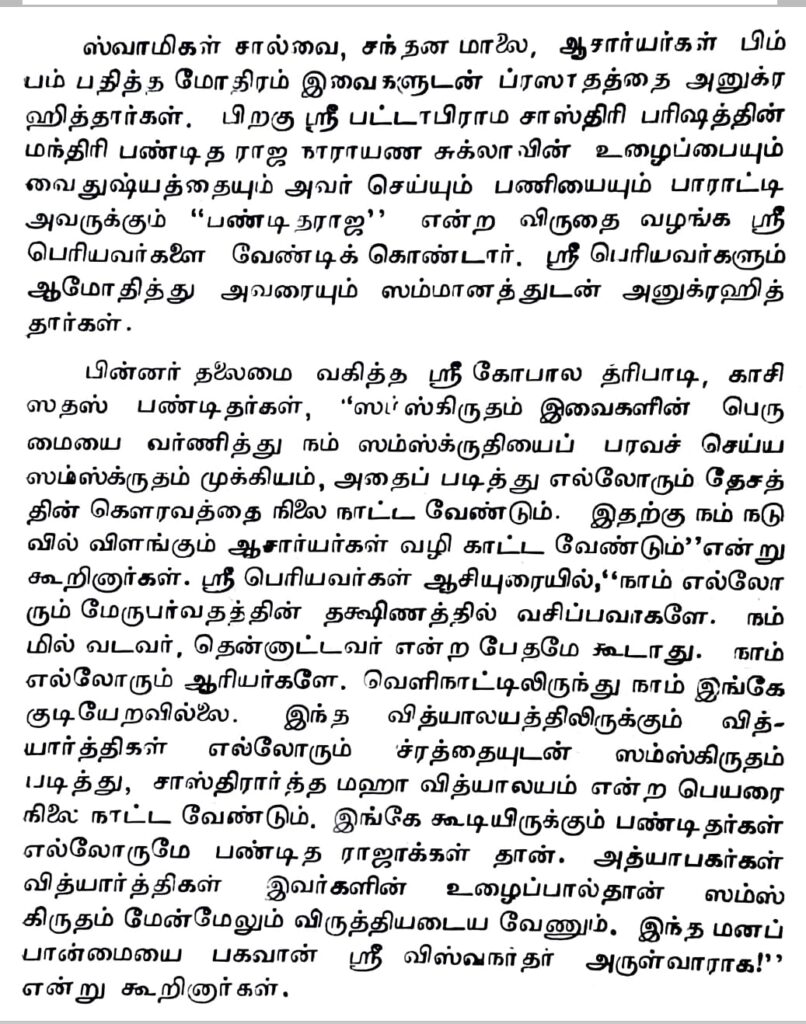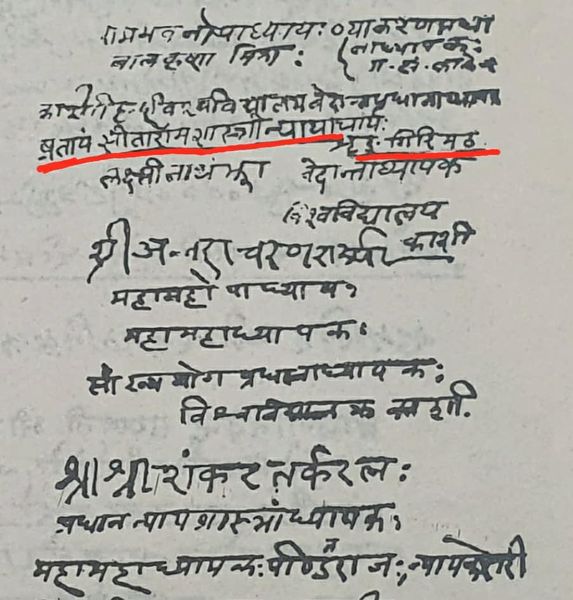ஸ்ரீபஞ்சானன தர்க்கரத்ன பட்டாசார்யர்.. (மூன்றாம் பகுதி)
1935-ஆம் ஆண்டு ஸெப்டம்பர் மாதம், 23-ஆம் நாள் மாலையில் ஸ்ரீ மஹா ஸ்வாமிகள் கல்கத்தா மாநகரிலுள்ள வங்காள ப்ராம்மண ஸபைக்கு விஜயம் செய்தார்கள்.
வங்கம் ப்ராம்மண ஸமூஹத்தினர் மட்டுமல்லாது, ஹிந்துஸ்தானி, மஹாராஷ்ட்ர, ஆந்த்ர, குஜராத்தி, தமிழ் ப்ராம்மணர்களுமாக சுமார் ஆயிரம் பேர்கள் அங்கு கூடி ஸ்ரீஸ்வாமிகளுக்கு மிக விமர்சையான வரவேற்பை அளித்தனர்.
ஸபையின் தலைவரான பட்டாசார்யர், ஸ்ரீமஹாஸ்வாமிகளுக்கு, ஸம்ஸ்க்ருத மொழியில் அச்சிடப்பட்ட நீண்டதோர் வரவேற்பு இதழை, வாசித்தளித்தார். அவ்விதழின் சில பகுதிகளின் தமிழாக்கம் கீழே கொடுக்கப்பட்டுள்ளது:-
“ஸ்ரீமத் ஆதி சங்கர பகவத்பாதரின் பரம்பரையின் ஜோதியாக ஸ்ரீகாமகோடி பீடத்தை அலங்கரிக்கின்றவர்களும், பரமேச்வரனின் மனித உருவமோ என ப்ரமிக்கும்படி, துறவிகளின் அரசராகத் திகழ்ந்து வரும் தங்கள் வரவு நல்வரவாகுக!”
“நமது தர்மம் யாதென அறியாது, துன்பக்கடலில் சிக்குண்டு தவிக்கும் மக்களை, தங்களது நல் உபதேசங் களாலும், கருணை மிகுந்த அருளாலும் கைகொடுத்துக் கரை ஏற்றி, நல்வழியில் நடத்திச் செல்லும். தங்கள் விஜயம், இக் காசி மாநகரத்திற்கு, இப்போது கிடைத்துள்ளது, நாங்கள் செய்துள்ள புண்யத்தின் பயனன்றி வேறில்லை. சிவபிரான் போன்று எங்கள் முன் ப்ரகாசிக்கும் தங்கள் திருவடித் தாமரைகளை வணங்கி, சில வார்த்தைகளைச் செப்ப விரும்புகின்றோம்”.
“ஸ்ரீஆதிசங்கரரது காமகோடி பீடத்தின் 68-ஆவது ஆசார்யாளாகவும், ஜகத்குருவாகவும் திகழும் தாங்கள். கருணையுடன் இங்கு விஜயம் செய்து, இப்பகுதியைப் புனிதமாக்கியது எங்கள் பெரும் பாக்யம்.’
“மேலும் புண்ய தீர்த்தங்களில் நீராடல், க்ஷேத்ரங் களிலும், ஆலயங்களிலும் ஸேவிப்பது, பின்னர் வரக்கூடிய ஒரு காலத்தில்தான் பயனை அளிக்கும். ஆனால் மஹான் களைத் தரிசிப்பதனாலேயே ஒரு மனிதனின் பிறவி கடைத்தேறுகின்றது, என பாகவதம் உணர்த்துகின்றது.”
“இத்தகைய மேன்மைகளையுடைய தங்களை எப்படிப் போற்றுவதென தெரியவில்லை; எனது வாக்குத் தழுதழுக்கின்றது, சரீரம் ஆனந்த பரவசத்தால் மயிர்கூச்சலடைகின்றது, கண்கள் ஆனந்தக் கண்ணீர் சொரிகின்றன.
மிக்க மங்களகரமான இந்த நன்னாளில், ஸனாதனமான நமது தர்மத்தைப் பிரதிஷ்டை செய்வதில் தீவிரமாக முயற்சித்து வரும் ஆசார்யமூர்த்திகளான தங்களுக்கு, எங்களது தழுதழுத்த குரலில், ஜயகோஷத்துடன் நல்வரவு கூறுகின்றோம்”.
(ஸ்ரீ அ.குப்புஸ்வாமி ஐயர் உள்ளிட்டோரின் குறிப்புகளிலிருந்து தொகுத்து வழங்கப்படும் தொடரின் மூன்றாம் பகுதி நிறைவுற்றது.)





















